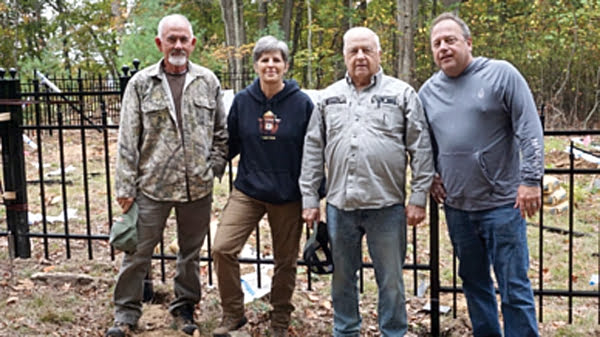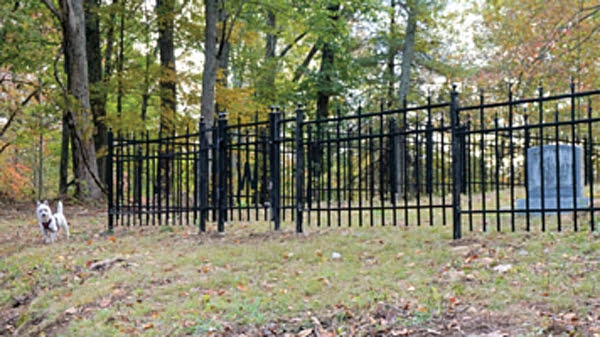
Ken Springer
Watoga Park Foundation
Why is there a fence around the cemetery?
It’s an old joke, and one likely to appeal only to a fifth-grader, but the answer is: “Because people are dying to get in.”
Ok, I can hear your collective groans, however there is a much more interesting reason why there is now a fence around the Workman Cemetery.
The Workman Cemetery is but one of an estimated 244 cemeteries in Pocahontas County – many of which are small family cemeteries. This cemetery, of some 14 or so members of the Workman family, is situated near the center of Watoga State Park, on a ridge above the headwaters of Rock Run. It is a prominent feature when hiking the Ann Bailey Trail.
David Workman left Pocahontas County in 1971 at the age of 24, bound for Florida. There, he became a successful millwright, married his wife, Bonnie Gail, and raised two sons. To keep up with news of his county of birth, he has subscribed to The Pocahontas Times for nearly 50 years.
It was in an earlier episode of the Watoga Trail Report that he read about the efforts to restore the Workman Cabin and the nearby family cemetery.
Back in the early part of the summer, I received a call from David in which he said that he would like to provide a fence to go around the border of the Workman Cemetery. He said that his son, Travis, is vice president of a fence company, and that they could travel up here to West Virginia in the fall and erect the fence.
Quite honestly, such a generous offer left me speechless. Which is a bit out of character for me, one who is often labeled as “loquacious” by various acquaintances with no particular affection for the art of conversation.
Anyway, I gathered the necessary words together to accept his offer.
At the time of David’s call, the Workman Cabin was in the process of restoration by the “log whisperer,” Ethan Burgess. The cabin was coming along nicely, so attention had turned to the state of the Workman Cemetery. The best adjective I can think of to describe the cemetery at that moment in time is “forlorn.”
Nature was having her way with the final resting place of some of Pocahontas County’s earliest residents. Trees had been coming up among the native-stone grave markers for many decades, dropping large branches directly onto the graves.
Locust and striped maple had encroached across the boundaries of the cemetery, leaving some of the graves in perpetual shade. Tall grass and greenbrier had taken over the open spaces, hiding some of the small stones that marked the graves of children. Other stone markers were lying askew, victims of freezing and thawing and the slow, but strong, grasp of tree roots.

Sollie and Anne Workman, of Hillsboro, made several trips to the cemetery to cut back the overgrowth and mark the graves with pin flags. Mark Mengele arrived at the cemetery on several occasions in his vintage Dodge Powerwagon, armed with a weed eater and saw. Still, there were large trees to clear if we were to protect the graves from any further insults.
Then the big guns were called in, and Dewey Burr and his crew took out the larger trees. It was starting to look like a cemetery again but something was missing, and it was obvious – a fence was sorely needed to define its borders. It was this fact that moved David Workman to contact me.
It needs to be pointed out that neither David nor Travis wished to attract any undue attention to their efforts. Both are, by all definitions, humble men. Knowing Sollie for some years now, I could be forgiven for assuming that humility is a family trait with the Workmans.
Travis, David and crew member Gustavo Gonzales arrived at Watoga State Park in the mid-afternoon on Friday, October 11. They and two other employees wasted no time in driving their trucks laden with fencing materials out to the Workman Cemetery to stage the work that would commence first thing on Saturday morning.
While the work crew got an early start out on the Ann Bailey Trail, David and I hiked into a location in the park that he had not seen since he was eight years old.
David recalled how his dad, Elmer David Workman, parked his truck at the TM Cheek Overlook. Then he and young David had hiked down to the old Krause Place, now just a jumble of rocks concealed by barberry bushes. It was here David learned that this was his father’s birthplace.
It was clearly an emotional experience for David, so many years had passed, yet he remembers it like it was yesterday. I took this opportunity to ask David why he went to such great effort and expense to see that a proper fence graced the Workman Cemetery.
His answer revealed much about his character.
“I feel that those people buried in the cemetery deserve a nice fence around their graves,” he said. “And my son and I are in a position to see that it gets done.”
Clearly stated and succinct, just what I expected from David.
Although the rest of the crew headed home after the fence was installed, David and Travis attended the evening potluck prepared in their honor by the Watoga State Park Foundation. After the celebratory affair was over they got back in their now-empty truck and started the 14-hour drive back to Florida.
As I watched their truck head off into the darkness I thought out loud, “There go two rare types of individuals; in days such as these, we need more of them.”
I know that my life has been further enriched just by getting to know David and Travis Workman.
How wonderful it would be to know who all of the unmarked graves belong to. These once-living people appear to be gone from living memory. Is it not our duty and obligation to remember each and every one of our departed?
Here’s how you can help:
We would like to know more about those who were interred in the Workman Cemetery. Please check your family bibles and photo albums for any information or pictures you may have about the cemetery. My email address can be found at the conclusion of this dispatch.
Many of you reacted to last week’s Watoga Trail Report, We Buried Our Own, about burial practices in rural Appalachia. The following are some of your remembrances and anecdotes in your own words.
“My aunt died at home eight years ago surrounded by her family. After we called the funeral home, I bathed her, changed her clothing, and combed her hair. It felt like my last act of love for her, and I wondered why that small comfort has been taken away from most people. There was something about those intimate moments that gave me a feeling of grace.” Jackie Obie Good
“I remember many of my family and friends who were a big part of my life and when they passed, their bodies were prepared and kept at home. There was such sweet respect. Women preparing food, men in suits and ties hanging out on the porch chatting in low tones.
The process of moving the casket from the house to the church and then the cemetery. Times are different now, but I think that the loss of a loved one is a grieving process that is healthier when taken slow and easy with respect.” Martha Edgar Ness
“This is a wonderfully written and compassionate insight into how death was accepted by our families in the not so distant past. They were very strong, much more so than I think that I could be.” Patti Rose
“I remember that my grandmother and grandfather were brought to the home for the wake and when they were carried out of the home, young ladies lined the outside walkway holding bunches of flowers. It was a much more personal and family thing then. They lived on a farm outside of Frankford, West Virginia.” Charlotte McKeever Emswiler
“I can remember attending the home wake of my great aunt when I was a child. And it was as described: Women in the kitchen preparing and arranging brought food. Men outside smoking and drinking occasionally.” Donna Mullins Ramsey
From the mountain trails of Watoga,
Ken Springer
ken49bon@gmail.com


